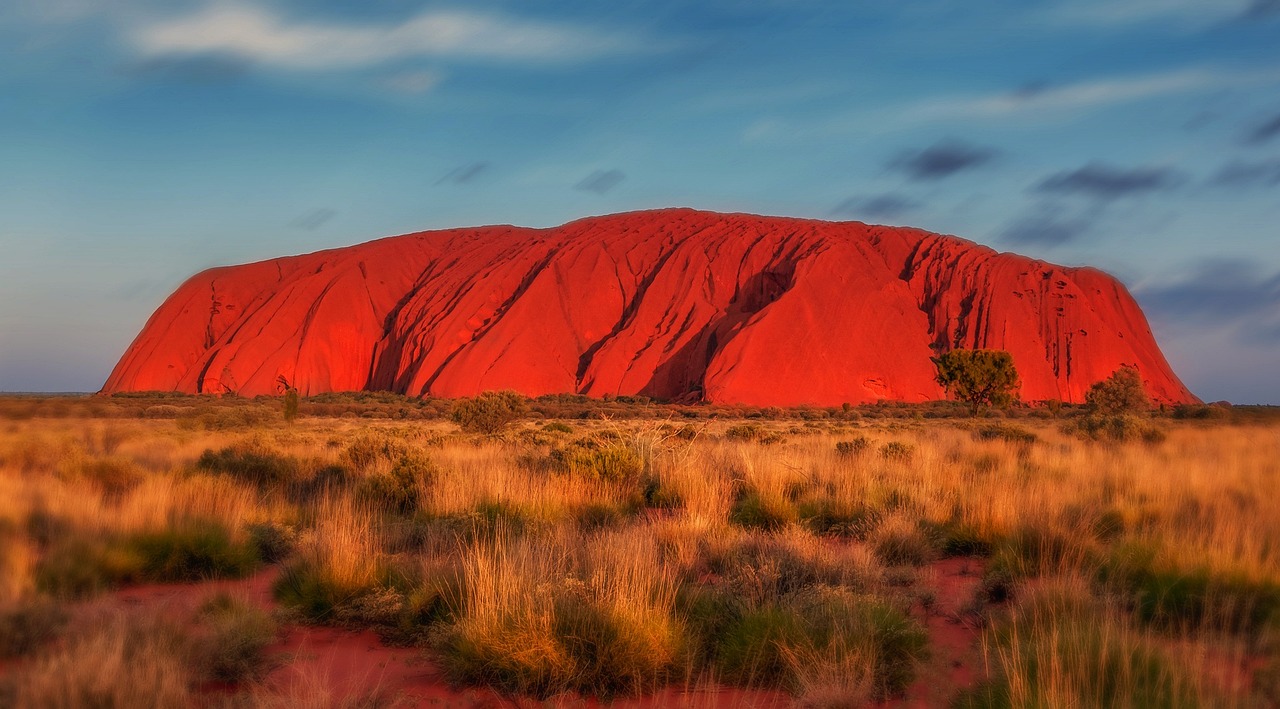
Uluru-Kata Tjuta National Park, located in the heart of Australia’s Red Centre in the Northern Territory, is one of the country’s most iconic and spiritually significant landscapes. Home to the majestic Uluru (Ayers Rock) and the mysterious Kata Tjuta (the Olgas), the park offers visitors a unique opportunity to connect with Australia’s rich Indigenous heritage and stunning natural beauty. This detailed guide provides everything you need to know about visiting Uluru-Kata Tjuta National Park, including its history, attractions, activities, accommodations, and travel tips.
Historical and Cultural Significance
Indigenous Heritage
Uluru-Kata Tjuta National Park is the ancestral land of the Anangu people, who have lived in the region for thousands of years. The park holds deep cultural and spiritual significance for the Anangu, who continue to maintain their traditions and customs. Visitors can learn about the Anangu culture, stories, and connection to the land through guided tours, cultural experiences, and interpretive centers.
UNESCO World Heritage Site
The park is recognized as a UNESCO World Heritage site for both its natural and cultural values. It is one of the few places in the world to be listed for both criteria, highlighting its exceptional significance.
Top Attractions
Uluru (Ayers Rock)
Uluru is a massive sandstone monolith that rises 348 meters above the desert floor and has a circumference of about 9.4 kilometers. It is renowned for its striking red color, which changes hues at different times of the day, particularly at sunrise and sunset.
Activities at Uluru:
- Base Walk: A 10.6-kilometer trail that circumnavigates Uluru, allowing visitors to explore its various features up close.
- Mala Walk: A shorter, guided walk that provides insights into the rock’s significance and the Anangu culture.
- Sunrise and Sunset Viewing: Designated viewing areas offer breathtaking views of Uluru as it changes color during sunrise and sunset.
- Field of Light: An art installation by Bruce Munro that features 50,000 spindles of light, creating a mesmerizing field of glowing orbs at the base of Uluru.
Kata Tjuta (The Olgas)
Kata Tjuta, meaning “many heads” in the local language, is a group of large, domed rock formations located about 25 kilometers west of Uluru. The highest peak, Mount Olga, rises 546 meters above the surrounding plain.
Activities at Kata Tjuta:
- Valley of the Winds Walk: A challenging but rewarding 7.4-kilometer loop that offers spectacular views of the domes and the surrounding landscape.
- Walpa Gorge Walk: A shorter, easier walk that takes visitors through a rocky path between two of the towering domes.
- Sunrise and Sunset Viewing: Like Uluru, Kata Tjuta offers stunning views during sunrise and sunset from designated viewing areas.
Cultural Experiences
Tjukurpa and Anangu Culture
Tjukurpa is the foundation of Anangu culture and encompasses their creation stories, law, and spirituality. Visitors can gain a deeper understanding of Tjukurpa through various cultural experiences:
- Cultural Centre: Located near Uluru, the Cultural Centre provides information about Anangu culture, history, and art. It also features galleries showcasing Indigenous art and crafts.
- Guided Tours: Several tour operators offer guided walks and experiences led by Anangu guides, providing insights into traditional practices, bush tucker (native foods), and the cultural significance of the landscape.
Accommodation
Ayers Rock Resort
Ayers Rock Resort, located in the nearby town of Yulara, offers a range of accommodation options to suit different budgets and preferences:
- Sails in the Desert: A luxury hotel featuring spacious rooms, a swimming pool, a spa, and fine dining options.
- Desert Gardens Hotel: A mid-range option with comfortable rooms, a swimming pool, and a restaurant with views of the desert.
- Outback Pioneer Hotel & Lodge: Offers a range of affordable accommodations, including hotel rooms, lodge rooms, and a campground.
- Longitude 131°: An exclusive, luxury glamping experience with stunning views of Uluru, offering private tents, fine dining, and personalized service.
Camping
For those who prefer a more rustic experience, there are campgrounds available at Ayers Rock Resort, offering both powered and unpowered sites, as well as facilities such as showers, kitchens, and barbecue areas.
Dining and Culinary Experiences
Ayers Rock Resort Dining
The resort offers a variety of dining options, from casual cafes to fine dining restaurants. Highlights include:
- Talinguru Nyakunytjaku Picnic Area: A beautiful spot for a picnic with views of both Uluru and Kata Tjuta.
- Ilkari Restaurant: Located at Sails in the Desert, offering a diverse menu featuring local and international cuisine.
- Arnguli Grill & Restaurant: At Desert Gardens Hotel, specializing in modern Australian cuisine with a focus on native ingredients.
- Sounds of Silence: A unique dining experience that includes a gourmet meal under the stars, with views of Uluru and Kata Tjuta, and accompanied by traditional stories and a didgeridoo performance.
Practical Information
Best Time to Visit
The best time to visit Uluru-Kata Tjuta National Park is during the cooler months from April to September, when temperatures are more moderate. The summer months (December to February) can be extremely hot, with temperatures often exceeding 40°C (104°F).
Getting There
Uluru-Kata Tjuta National Park is accessible by air, road, and rail:
- By Air: The nearest airport is Ayers Rock Airport (Connellan Airport), which is located about 20 kilometers from Uluru. Regular flights are available from major Australian cities.
- By Road: The park is accessible by road via the Stuart Highway and Lasseter Highway. It is approximately 450 kilometers from Alice Springs.
- By Rail: The Ghan, a luxury train service, runs between Adelaide and Darwin, stopping in Alice Springs. From there, visitors can take a coach or hire a car to reach the park.
Park Fees and Permits
Visitors to Uluru-Kata Tjuta National Park are required to pay an entry fee, which helps support the management and conservation of the park. The fee is valid for three consecutive days and can be purchased at the park entrance or online.
Health and Safety
When visiting Uluru-Kata Tjuta National Park, consider the following health and safety tips:
- Sun Protection: The sun can be intense, so wear high-SPF sunscreen, a hat, sunglasses, and protective clothing. Stay hydrated by drinking plenty of water.
- Walking and Hiking: Stay on designated trails, carry sufficient water, and inform someone of your plans before setting out on longer walks.
- Respecting Cultural Significance: Uluru is a sacred site for the Anangu people. Visitors are asked to respect their culture by not climbing Uluru and by following guidelines provided by the park authorities.
Environmental Conservation
Uluru-Kata Tjuta National Park is a protected area, and visitors are encouraged to follow all guidelines for conservation, including not disturbing wildlife, disposing of waste properly, and staying on designated paths.
Conclusion
Uluru-Kata Tjuta National Park is a destination of unparalleled beauty and cultural significance. From the awe-inspiring sight of Uluru and the mystical Kata Tjuta to the rich cultural experiences and adventure activities, the park offers something for every traveler. By respecting the cultural heritage and natural environment, visitors can enjoy an unforgettable experience while contributing to the preservation of this unique and sacred landscape. Whether you’re seeking spiritual connection, outdoor adventure, or simply the chance to witness one of the world’s most iconic landmarks, Uluru-Kata Tjuta National Park promises a journey that will leave a lasting impression.


